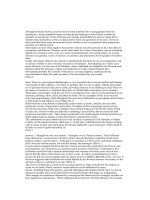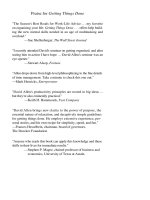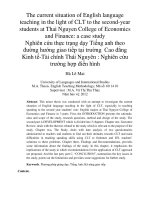how m butterfly uses the art of illusion to foster stereotypes among its main characters
Bạn đang xem bản rút gọn của tài liệu. Xem và tải ngay bản đầy đủ của tài liệu tại đây (41.21 KB, 3 trang )
Throughout human history, societies have divided members into varying groups based on
stereotypes using simplified images to bring special meaning to traits held in common by
members of each group. These stereotypes are usually learned behavior and are spoon-fed to
families and communities as they are passed down from one generation to the next. However,
each individual must make the personal choice whether or not to incorporate these impressions
into their own belief system.
Stereotypes are more often negative than positive and are not always based on fact, but rather on
perceptions and illusions. Illusions, on the other hand, are a form of deception, seen as something
objectively existing in such a way as to cause misinterpretation of its actual nature. As a result,
illusions can generate a sense of mystery, excitement, and anticipation for the people who harbor
them.
Unlike stereotypes, illusions are created or interpreted by the limits of our own imagination, and
we choose whether or not to become swayed by our fantasies. Stereotyping can in some cases
create illusions, as is the case in M. Butterfly, where Gallimard was blinded by his Western male
fantasies about the submissive nature and tendencies of Asian women.(Stratton Pg1)
Most people probably like to think of themselves as being impartial, unaffected by the
conventionalized ideas that make up many of the stereotypes they see around
Fleck 2
them. However, stereotypical thinking plays a very powerful role in our perceptions and dealings
with people of other cultures even more so, perhaps, than we care to admit. Maybe stereotypes
are so persistent because they prove useful, providing shortcuts to our thinking in areas where we
are unsure of ourselves, or skeptical about how we should think concerning a given situation.
Stereotypes occasionally creep into our lives in unexpected ways, and are even perpetuated in our
literature, paintings, films, music and other art forms. We see examples of this in movies and
television programming, which throughout the years have influenced our perceptions about Asians
in both positive and negative ways.(Major Pg 3)
Hollywood has a long history of portraying Asian women as exotic, and they also are often
portrayed as erotic, sensual and overly sexual. Examples of these stereotypes can be seen in
movies like Sayonara, Walk Like a Dragon, Flower Drum Song, and The World of Suzy Wong.
In each case, oriental women are depicted as assuming a sexual allure and are viewed as both
mysterious and subservient. These images portrayed by the media moguls in Hollywood have no
doubt helped endorse already existing stereotypes in mainstream society.
The combination of quiet submission and overt sexuality as portrayed in M. Butterfly is further
evidence of this characterization. (Hicks pg 2) In this play, Gallimard feeds his fantasy of being
with an Asian woman with artful guile, his illusion inspired by Asian stereotypes. When asked if
he had ever seen his girlfriend naked, he
Fleck 3
answers: "I thought she was very modest. I thought it was a Chinese custom." Had Gallimard
been attracted to a woman from a Western culture, this self-deception would have been much
harder to achieve, and to believe. Although it is customary in China to bow and blush, Gallimard
fell in love not with the person, but with the fantasy, the stereotype. (Rich 1)
It seems hard to imagine that those that have read or seen the play particularly the French, who
stereotypically view themselves as somewhat expert in affairs of the heart would believe that
Gallimard could have had a intimate relationship with someone for twenty years and not have
known that the object of his desires was, in fact, a man. In reality, he pretended not to know
because he did not want to impinge upon his desire to have a Madame Butterfly of his very own. It
has been suggested that Gallimard was indeed blinded by his Western fantasies the fantasy of the
oriental women as a submissive servant. (Ebert 2)
The level of satisfaction we achieve for out sexual desires is often controlled by the images we
create in our minds. While a person's sexual behavior can be influenced by many
factors including things like genetics, parental upbringing and religious beliefs how we end up
acting out sexually also can be influenced by the mental images that shape our imaginations.
These images are sometimes influenced by stereotypes that cannot easily be changed, and that can
have dangerous consequences. When Gallimard entered into his whirlwind illusion, for example,
his self-deception not only allowed him to engage in a fantasy relationship but also permitted him
to be
Fleck 4
undone by a spy. (Moy) In this case, this illusion, this false perception of reality, was self
destructive since it led to Gallimard's eventual downfall.(Davis 6)
The way Gallimard slipped into ruination by crossing the line of healthy fantasy into a world of
false conceptions got me thinking about the way we allow illusions to influence our daily lives. It
is one thing to hope that something can happen, or to wish for something we desire to occur. It's
an entirely different circumstance to be convinced that something will happen simply by believing
in it. It's clear that illusions can lead to destructive behavior, as illustrated by the case of Gallimard
in M. Butterfly. When our perception of reality is altered to such a state where we are seeing only
what we want to see, instead of what is actually occurring, we begin to enter into a very dangerous
area. When we begin to act on these illusions, however, we only add to the problem. In the play
M. Butterfly there were times when Gallimard was totally absorbed in his own false beliefs. For
example, when Song produced a child that he claimed was his, Gallimard never questioned it.
Living in this sort of fantasy world cost Gallimard his marriage, his career and eventually his life.
The most devastating moment must have occurred when he finally realized just how far he had
allowed himself to go, and that he had no way of transforming twenty years of his life into some
form of reality.(Moy 1)
Sometimes the term "she's pulling a Butterfly" is used among Asian woman to describe a
submissive behavior of sorts (Stratton). I can only hope that in today's modern world, women of
Asian descent are frowning upon this form stereotyping. And that today, Asian women have
advanced to the point of being deeply disturbed by these stereotypes.
Fleck 5
From a feminist perspective, M. Butterfly can be seen as being conceived as a form of revenge.
One can only imagine that ever since its inspiration, Madame Butterfly, was first staged, feminist
have been awaiting an opportunity to affect revenge, and M. Butterfly fits the bill. To begin with,
Gallimard, as the dominating Western male figure, seeks to control a submissive oriental woman.
This fact is borne out by his insistence that she admit to being his "butterfly". The set up is quite
similar to the original play, right up to the surrendering of Song's character. What subsequently
follows, however, is a complete turning of the tables. To make matters even worse, the object of
his downfall is a man posing as a woman. As a result of his stereotypical delusions, he loses
control not only of his "butterfly" but also over his entire life, resulting in the act of suicide.
When we look at relations between men and women from the East and from the West, we see that
Asians are often portrayed as being either enraptured or suspicious of their Western counterparts.
This is an underlining theme in the play, and it affects not only Gallimard personally but his
political party as well. (Davis 6)
When we observe people as groups and form stereotypes, we are creating illusion in their simplest
form. Such behavior can be destructive for both the observer and those being surveyed. This is
clearly witnessed in the play M. Butterfly. Gallimard is drawn to a stereotype shaped by his own
illusions. The illusion quickly becomes a twenty-year fantasy that consumes him to the point of
self-destruction. And as a result, he paid the ultimate price. (Davis 6)
Fleck 6
Works Cited
Stratton, Jerry. "FireBlade, Book Review: M. Butterfly"
( />Hicks, Chris. "Desert News Movie Review"
( />Rich, Frank. "Reviews"
( butterfly.htm)
Elbert, Robert. "Chicago Sun-Times"
( />Moy, James S. "Classroom Issues and Strategies"
(rgetown,edu/faculty/bassr/health/syllabuild/iguide/hwang.html)
Davis, Rocio. "Just a Man: Subverting Stereotypes in David Henry Hwang's M. Butterfly"(Vol 6,
No 2)
( />Major, John S."Asia Through a Glass Darkly:Stereotypes of Asians in Western Literature (Vol V
No 3)
/>









